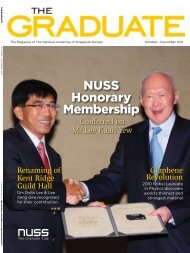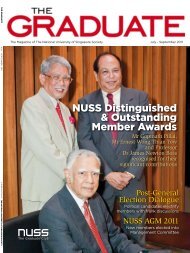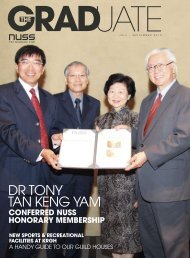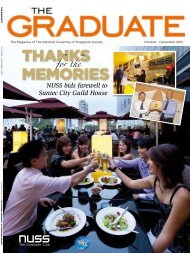The view from singapore with British High Commissioner to ... - NUSS
The view from singapore with British High Commissioner to ... - NUSS
The view from singapore with British High Commissioner to ... - NUSS
You also want an ePaper? Increase the reach of your titles
YUMPU automatically turns print PDFs into web optimized ePapers that Google loves.
weaker and slower than their younger<br />
counterparts. This forces them <strong>to</strong><br />
retire and survive on their meagre<br />
savings or familial support. With the<br />
senior population increasing and a<br />
tighter control on foreign workers,<br />
our workforce will potentially shrink.<br />
<strong>The</strong> Retirement and Re-Employment<br />
Act (RRA) was implemented <strong>to</strong> make<br />
it compulsory <strong>to</strong> a certain extent for<br />
employers <strong>to</strong> rehire employees till 65,<br />
three years beyond their official retirement<br />
age. <strong>The</strong> Tripartite Alliance for<br />
Fair Employment Practices (TAFEP)<br />
was set up <strong>to</strong> advance this regulation<br />
as well. At press time, 2,059 companies<br />
had pledged <strong>to</strong> exercise fair<br />
employment of older workers since<br />
the last quarter of year 2012.<br />
As employers determine whether<br />
a mature worker is medically fit for<br />
re-employment, older people who are<br />
healthy have a higher chance of being<br />
employed. Young people will also<br />
be likely <strong>to</strong> welcome older workers<br />
back in the workforce if the latter’s<br />
employment will relieve the former<br />
<strong>from</strong> the burden of supporting them.<br />
<strong>to</strong>wards Independent living<br />
By the year 2030, the number of<br />
older people who are living alone is<br />
expected <strong>to</strong> increase <strong>from</strong> the current<br />
35,000 <strong>to</strong> 83,000. However, this figure<br />
does not include seniors who are<br />
alone at home while their children are<br />
at work. <strong>The</strong>re is an estimated 85 percent<br />
of elderly living <strong>with</strong> at least one<br />
child. Judging <strong>from</strong> the co-residence<br />
statistics, it seems that most Singaporeans<br />
have opted <strong>to</strong> stay <strong>with</strong> their<br />
parents. To a certain extent this is true<br />
but research has also shown that one<br />
of the main reasons for persistently<br />
high co-residence rates in Singapore<br />
maybe the higher housing costs rather<br />
than a sign of increased support for<br />
older parents.<br />
Increasingly, more Singaporeans<br />
are single or marrying later. According<br />
<strong>to</strong> <strong>The</strong> Census of Population 2010, the<br />
number of singles aged between 30<br />
<strong>to</strong> 34 years rose <strong>from</strong> 33 percent <strong>to</strong><br />
43 percent for men and 22 percent <strong>to</strong><br />
31 percent for women. <strong>The</strong> statistics<br />
also revealed that more men <strong>with</strong><br />
below-secondary education and<br />
graduate women were singles. By<br />
<strong>to</strong>day, this group would have turned<br />
35 years old, met the required criteria<br />
HouSinG & DevelopMenT BoarD flaTS<br />
cover s<strong>to</strong>ry<br />
DesIgns For tHe elDerly<br />
Interior of an HDB Studio Apartment.<br />
Home Improvement Programme –<br />
Replacement of pipe sockets <strong>with</strong> new<br />
clothes drying rack<br />
EASE Programme – Installation of grab bars<br />
<strong>to</strong> provide support and enhance balance for<br />
the elderly at the doorway of the kitchen.<br />
According <strong>to</strong> 2011 Statistics Singapore<br />
figures, 29 percent of residents aged 65<br />
and above have been staying in Housing &<br />
Development Board (HDB) 4-room flats and<br />
24 percent in 3-room flats.<br />
and be eligible <strong>to</strong> buy their own flats.<br />
As many singles have aspirations as<br />
well, the Government has relaxed<br />
their policy on singles buying new<br />
HDB flats (a less expensive option)<br />
as opposed <strong>to</strong> being limited <strong>to</strong> buy<br />
resale flats <strong>from</strong> the open market.<br />
Besides such varied concerns and<br />
aspirations of singles and other<br />
groups of individuals <strong>to</strong> cater <strong>to</strong>, the<br />
Inter-Ministerial Committee (IMC)<br />
has also proposed the creation of a<br />
conducive environment for the elderly<br />
<strong>to</strong> age-in-place.<br />
In this respect, HDB has adopted<br />
a holistic approach <strong>to</strong> meet the living<br />
needs of the elderly. Since 1998, HDB<br />
had introduced SAs that are equipped<br />
<strong>with</strong> elderly-friendly fittings. In<br />
line <strong>with</strong> IMC’s goal of social<br />
integration rather than segregation,<br />
SAs are integrated <strong>with</strong> other flat<br />
types <strong>with</strong>in the same block and in<br />
standalone blocks. According <strong>to</strong> a<br />
HDB spokesperson, the take-up rates<br />
of the existing 8,000 SAs is almost<br />
100 percent.<br />
Under several improvement<br />
schemes <strong>to</strong> create an improved<br />
barrier-free environment, additional<br />
age-friendly features are also added<br />
in elderly housings and at common<br />
areas. <strong>The</strong> Code on Barrier-free<br />
Accessibility in Buildings will apply<br />
<strong>to</strong> new HDB developments and<br />
progressively extended <strong>to</strong> older<br />
Jan-Mar 2013 THE GRADUATE 7









